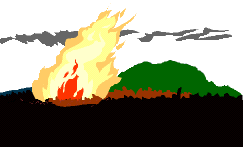
![]()
![]()
 Old Growth on Magnolia
Old Growth on MagnoliaWhat is Old Growth? Well, it depends on whom you ask. According to the Forest Service, old growth is 20 acres or more of forest that consists predominantly of trees with at least an 18 inches diameter at breast height. Jeff Moline of Boulder County Open Space feels that the Forest Service's definition is too liberal, allowing too many areas to qualify as old growth when, in fact, true old growth areas are rare.
 While discussing old growth with the PUMA
wildlife committee members, Moline stressed that old growth is
not a single tree; rather, it is an ecosystem. Wildlife that
inhabits Old Growth does not know the age or diameter of the
trees, but is there because the habitat provides them with the
essentials they need to survive. Old Growth provides an abundance
of nesting sites and cover, large expanses of interior forest
that are not segmented by roads or trails, and a diversity of
food resources.
While discussing old growth with the PUMA
wildlife committee members, Moline stressed that old growth is
not a single tree; rather, it is an ecosystem. Wildlife that
inhabits Old Growth does not know the age or diameter of the
trees, but is there because the habitat provides them with the
essentials they need to survive. Old Growth provides an abundance
of nesting sites and cover, large expanses of interior forest
that are not segmented by roads or trails, and a diversity of
food resources.
What does it look like? In an Old Growth pine forest, you would be able to walk and move freely and easily. The trees would be widely spaced with no lower branches, creating a park-like setting with grass underneath and a few shrubs. There would be a few standing dead snags (two or more per acre) and large logs lying on the forest floor. If you could look across a valley at the forest, the varying height of tree tops would indicate that trees were not all from a single age class.
 Today, we must use our imaginations to picture an
old growth pine forest because none really exists in Boulder
County. According to Moline, because of the practices of loggers
and miners in the early 1900s, it is rare to find any
ponderosa pine over 125 years old. Most of the ponderosa on
Magnolia are just 70-90 years old.
Today, we must use our imaginations to picture an
old growth pine forest because none really exists in Boulder
County. According to Moline, because of the practices of loggers
and miners in the early 1900s, it is rare to find any
ponderosa pine over 125 years old. Most of the ponderosa on
Magnolia are just 70-90 years old.
The scarcity of Old Growth areas makes it necessary to locate, identify and protect the few trees that remain. Why is it important? An Old Growth area provides a type of habitat upon which some plant and animal species are very dependent. Without old growth areas, some species may suffer—this is particularly true for many bird species, including the Flammulated Owl and the Goshawk. Currently, PUMA members are doing field work to survey local populations of these two species because their presence is likely to indicate old growth areas. Finding these species will be a first important step in the possible identification, and ultimately, the protection of old growth areas, as well as of two rare and beautiful bird species.
Will our trees become Old Growth? It is not likely that the trees and forests around us now will turn into Old Growth. Old growth is created by recurrent, low intensity lightning-initiated ground fires. With current development in the mountain areas and the consequent need to suppress fires, the trees will not receive the thinning agent which burns the understory and lower limbs, burns away litter of needles, enhances the fertility of the soil, clears out dense stands of pine seedlings and creates the open, park-like habitat of old growth.
The fact that new old growth areas are not likely to evolve, makes the areas that we are able to locate even more important. If you would like to know more about Old Growth areas or would like to get involved in the inventories and surveys that we are currently undertaking, please contact PUMA's Wildlife Working Group.
![]()
The skies seem to be getting bluer every day; the sun a little brighter. This may be a reminder of the beauty of summertime, but it should also be a reminder of the increasing fire danger. Despite occasional afternoon showers, fire danger in the mountains remains high. The small amount of precipitation these rains bring does little to reduce the fire danger. The abundance of dry grasses and dead trees, a forest floor full of debris from years of fire suppression, these make for a dangerous situation.
 The area around Magnolia
Road is one of several areas within Colorado which have been
categorized as a Red Zone. Red zones are
areas of primary concern to the Forest Service because
of the vast quantities of fuels in our area. As it stands now, if
a wildfire were to occur in this area, the amount of dead trees
and fuel would almost guarantee catastrophic damage. Most of the
accumulation is due to decades of suppressed burning - a practice
that is now being revised.
The area around Magnolia
Road is one of several areas within Colorado which have been
categorized as a Red Zone. Red zones are
areas of primary concern to the Forest Service because
of the vast quantities of fuels in our area. As it stands now, if
a wildfire were to occur in this area, the amount of dead trees
and fuel would almost guarantee catastrophic damage. Most of the
accumulation is due to decades of suppressed burning - a practice
that is now being revised.
In response to this concern, the Forest Service has applied for funding that will enable them to work in conjunction with area residents to help improve the health of the forests and reduce fire danger.
PUMA has met with District Ranger Bill Anthony and has been invited to play an active role in this plan. The overall goal is to incorporate existing firebreaks like roads and meadows with a thinning effort in designated areas. In order to preserve some of the larger trees and old growth characteristics, emphasis will be on removal of smaller, thinner trees.
Despite the eagerness of all involved, it will be many years down the road before our forests are able to sustain even a controlled burn - not to mention a wildfire. So this is no time to relax our vigilance!
To protect our Community
Be on the lookout for fire rings, particularly in areas well-known for camping, and check to be sure they are completely out. Even warm ashes, with the right wind and conditions, can spark a fire. Carry extra water with you when you walk, bike or ride in case you come upon such a situation. To protect your home: Thin trees close to your home, cut any branches that touch or are close to your house, create a 30 ft. radius where tree branches are not touching, and try to clear the area within that radius of pine cones and needles. Turn off and unplug appliances when they are not in use. Never undertake any kind of burning without the express consent of the Fire Department. Fires are a powerful force of nature. We may not be able to stop a full-fledged forest fire, but we should at least do our part in preventing one.
For more information about fire safety, PUMA has a Fire Mitigation Group; we will be happy to give you information and answer your questions. You can contact us at puma@magnoliaroad.net.
We all want to protect our local ecosystem and to maintain a healthy environment. But how do we know what a healthy environment is? What symptoms do we measure to gauge the health of our back-yard?
One way is through observations of an "indicator species", an animal or plant which is very sensitive to changes in their environment. For example, canaries have long been used as an indicator for coal miners because of the bird's sensitivity to gas leaks. Miners kept a caged canary close to the area of coal removal; if the canary stopped singing, it was time to leave or ventilate the mine.
While there is no equivalent canary for the forests and meadows of Magnolia, the elk in this area can tell us a lot about our environment. Though forest biologists use the elk somewhat reluctantly, common game and familiar wildlife are often chosen as indicator species. It is easy to get information through hunters' reports, fishermen's records, bird watchers' sightings, etc.. On Magnolia, elk are used because they are easily tracked, counted and studied; they are used reluctantly though, because they are somewhat insensitive to human disturbance, the very factor that impacts the status and health of our Magnolia ecosystem the most.
Dennis Lowry, Forest Biologist for the US Forest Service, Arapaho-Roosevelt National Forests, would prefer not to use indicator species at all, but the law (National Forest Management Act - NFMA) requires that he do so. He suggests that the study of an active ecological community would be better; we should look at the whole rather than a part. Species can be added to those under study as needs change. Department of Wildlife biologist Chris Kloster supports this. "Elk are not a good indicator species, especially for small parcels like the Magnolia area. They habituate to people and don't respond to forest fragmentation - both things that we know have substantial effect on the overall health of the forest." Kloster noted, "These mammals will fit in just about anywhere."
Despite their adaptability, elk can provide some useful information. Their numbers indicate a plentiful supply of browse. If there is competition from other grazing animals, domestic and wild, the elk population will change. Mountain lions, a sign of a healthy, varied ecosystem, prey on deer and elk. If elk populations get too large, it is a sign that there are too few predators. If elk populations remain stable, you can count the invisible lion as part of that ecosystem, even if you can't find them.
Elk are sensitive to the availability of thermal cover; forests that provide wind breaks, easier travel in heavy snows, and a generally easier time for the elk. Biologist Rosalind Yanishevsky says, "After the Black Tiger wildfire on Sugarloaf there is plenty of forage, but the elk do not appear in great numbers possibly because there is no thermal cover. A healthy forest with good structural diversity provides this thermal cover." Yanishevsky went on to say, "Population structure can also tell us a great deal. If the ratio of females, males and young changes dramatically, especially females, there should be great concern about the causes".
While establishing that a population of some chosen indicator species has changed is relatively easy, determining why that change occurred is sometimes not so clear. First, however, it is important to know that a change is taking place. Both Lowry and Kloster agree that citizen input can be critical since research is not often conducted on private land. In areas like Magnolia, where there is almost as much private as public land, residents can make a valuable contribution to these biological studies.
PUMA will continue to work with the Department Of Wildlife and the Forest Service to keep residents informed of how they can contribute and thereby be part of the process of maintaining a healthy ecosystem.